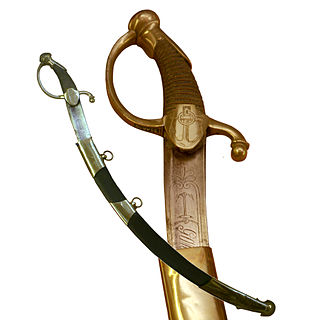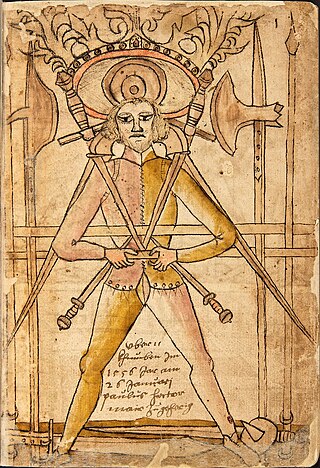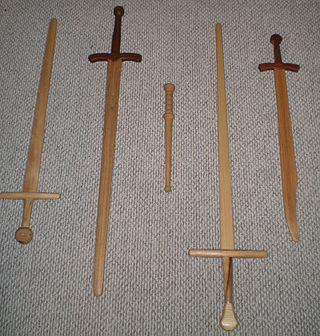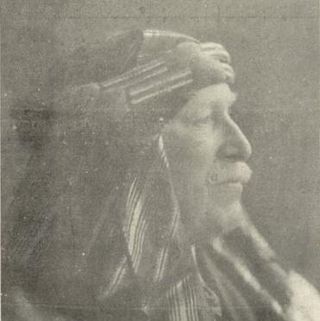
A quarterstaff, also short staff or simply staff is a traditional European pole weapon, which was especially prominent in England during the Early Modern period.

A sabre is a type of backsword with a curved blade associated with the light cavalry of the early modern and Napoleonic periods. Originally associated with Central European cavalry such as the hussars, the sabre became widespread in Western Europe during the Thirty Years' War. Lighter sabres also became popular with infantry of the early 17th century. In the 19th century, models with less curving blades became common and were also used by heavy cavalry.
A backsword is a type of sword characterised by having a single-edged blade and a hilt with a single-handed grip. It is so called because the triangular cross section gives a flat back edge opposite the cutting edge. Later examples often have a "false edge" on the back near the tip, which was in many cases sharpened to make an actual edge and facilitate thrusting attacks. From around the early 14th century, the backsword became the first type of European sword to be fitted with a knuckle guard.

A longsword is a type of European sword characterized as having a cruciform hilt with a grip for primarily two-handed use, a straight double-edged blade of around 80 to 110 cm, and weighing approximately 1 to 1.5 kg.

A club is a short staff or stick, usually made of wood, wielded as a weapon since prehistory. There are several examples of blunt-force trauma caused by clubs in the past, including at the site of Nataruk in Turkana, Kenya, described as the scene of a prehistoric conflict between bands of hunter-gatherers 10,000 years ago.

Swordsmanship or sword fighting refers to the skills and techniques used in combat and training with any type of sword. The term is modern, and as such was mainly used to refer to smallsword fencing, but by extension it can also be applied to any martial art involving the use of a sword. The formation of the English word "swordsman" is parallel to the Latin word gladiator, a term for the professional fighters who fought against each other and a variety of other foes for the entertainment of spectators in the Roman Empire. The word gladiator itself comes from the Latin word gladius, which is a type of sword.

Historical European martial arts (HEMA) are martial arts of European origin, particularly using arts formerly practised, but having since died out or evolved into very different forms.
Martial arts manuals are instructions, with or without illustrations, specifically designed to be learnt from a book. Many books detailing specific techniques of martial arts are often erroneously called manuals but were written as treatises.

The English language terminology used in the classification of swords is imprecise and has varied widely over time. There is no historical dictionary for the universal names, classification or terminology of swords; a sword was simply a double edged knife.

A dusack is a single-edged sword of the cutlass or sabre type, in use as a side arm in Germany and the Habsburg monarchy during the 16th to 17th centuries, as well as a practice weapon based on this weapon used in early modern German fencing.

Stick-fighting, stickfighting, or stick fighting, is a variety of martial arts which use simple long, slender, blunt, hand-held, generally wooden "sticks" for fighting, such as a gun staff, bō, jō, walking stick, baston, arnis sticks or similar weapons. Some techniques can also be used with a sturdy umbrella or even with a sword or dagger in its scabbard.

In martial arts, a waster is a practice weapon, usually a sword, and usually made out of wood, though nylon (plastic) wasters are also available. Nylon being much safer than wood, due to it having an adequate amount of flex for thrusts to be generally safe, unlike wooden wasters. Even a steel feder has more flex than most wooden wasters. The use of wood or nylon instead of metal provides an economic option for initial weapons training and sparring, at some loss of genuine experience. A weighted waster may be used for a sort of strength training, theoretically making the movements of using an actual sword comparatively easier and quicker, though modern sports science shows that an athlete would most optimally train with an implement which is closest to the same weight, balance, and shape of the tool they will be using. Wasters as wooden practice weapons have been found in a variety of cultures over a number of centuries, including ancient China, Ireland, Iran, Scotland, Rome, Egypt, medieval and renaissance Europe, Japan, and into the modern era in Europe and the United States. Over the course of time, wasters took a variety of forms not necessarily influenced by chronological succession, ranging from simple sticks to clip-point dowels with leather basket hilts to careful replicas of real swords.
In Irish martial arts, bataireacht now refers to the various forms of stick-fighting from Ireland. Although an old term it was found by author John W. Hurley and introduced back into modern usage in the late 1990’s. Bataireacht literally means “fighting with sticks” and has no specifically “Irish” connotation at all, but Hurley thought it a convenient word to use for non-Irish speakers since it is indeed Irish and does connote fighting, or fencing, with 3 foot sticks.

Fencing – family of combat sports using bladed weapons. Fencing is one of four sports which have been featured at every one of the modern Olympic Games. Also known as modern fencing to distinguish it from historical fencing.

The shashka or shasqua, is a kind of sabre; a single-edged, single-handed, and guardless backsword. In appearance, the shashka is midway between a typically curved sabre and a straight sword. It has a slightly curved blade, and can be effective for both cutting and thrusting.
A Prize Playing was a test of martial skill popular in Renaissance England with the London-based Corporation of Masters of the Noble Science of Defence. It involved several dozen bouts against continually refreshing opponents, with little or no rest in between.

Rowland George Allanson Allanson-Winn, 5th Baron Headley, also known as Shaikh Rahmatullah al-Farooq, was an Irish peer and a prominent convert to Islam, who was also one of the leading members of the Woking Muslim Mission alongside Khwaja Kamal-ud-Din. He also presided over the British Muslim Society for some time.

The basket-hilted sword is a sword type of the early modern era characterised by a basket-shaped guard that protects the hand. The basket hilt is a development of the quillons added to swords' crossguards since the Late Middle Ages. In modern times, this variety of sword is also sometimes referred to as the broadsword.
There is some evidence on historical fencing as practised in Scotland in the Early Modern Era, especially fencing with the Scottish basket-hilted broadsword during the 17th to 18th centuries.















